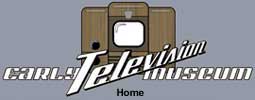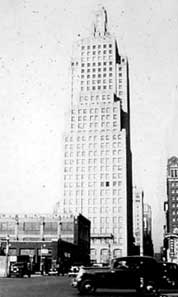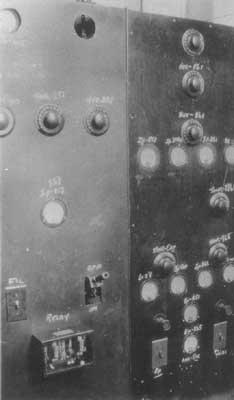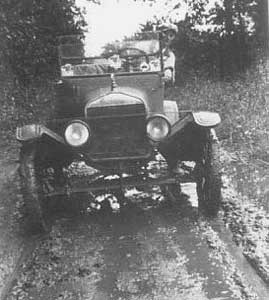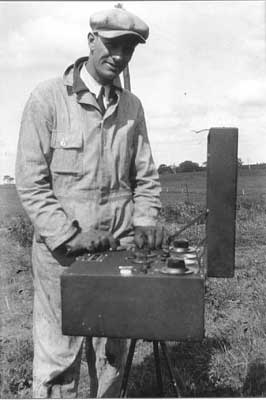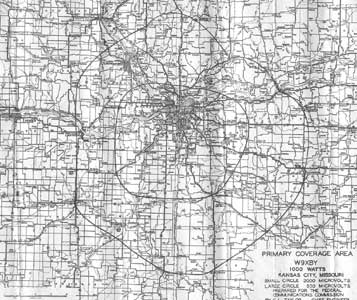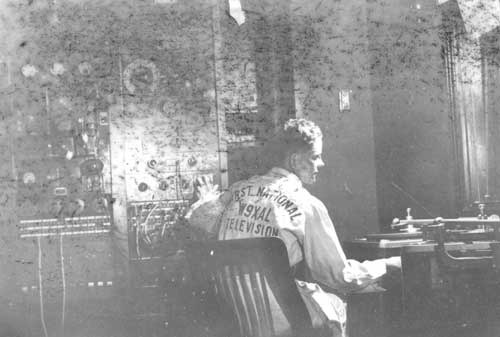Early Electronic Television First National TelevisionThe Building, the School & the Stations W9XAL & W9XBYAs REMEMBERED by its Graduate Engineer, Newcomb Weisenberger I am an very early, resident graduate of the FNT School in 1935. I have been a radio engineer for KFI in Los Angles, and retired after 33 years. I found a copy of a 1936 issue of the Midland Student Engineer paper. I knew the author of this article. It was a good school. I have never been unemployed.
Newcomb Weisenberger, carefully holding a transmitter tube. This is 1935. First National Television, training division has no classrooms, lecture halls or printed books. The classes are very small, 3-6 young men each. Some of our instructors are engineers. Instructors write our lessons. Word processors and printers do not exist. There is no WWWeb, modern air conditioning or things like NRA, REA, WPA etc. That means that the much of the Country is not yet wired for electricity. That even parts of downtown Kansas City are using 25 -cycle power (Numerous listeners to W9XBY were using car batteries to operate their receivers. The velocity microphone has just been invented. There are no solid-state devices. W9XBY is a pioneer, broadcasting High Fidelity audio. 15-15,000 cycles, (not Hertz) Stereo sound isn't mentioned. Here were the advantages for the resident student at FNT: Our classrooms were the live, on-the-air stations W9XBY and W9XAL. We were receiving almost individual attention. These two stations were also our lab, full scale and complete examples of what we needed to know. Our Television lesson sheets were as current as the Kansas City Star! We discussed cathode ray screens and electronic scanning before they were put to use. Chief Engineer Taylor shared this before our lessons were typed and duplicated. ----------------------------- The family had entered my rented room. Sort of huddled there, listening to W9XBY on the unbaffled speaker. (The volume was set very low.) The old man and his two adult daughters were sharing the only the light, A glow, from the naked dial-lamp. I was surprised and they were embarrassed. They didn't have a radio and I was studying at First National Television. (No one had a TV receiver.) Our Tall Schoolhouse
Kansas City is cold in February. My Woodland streetcar is moving north in slow traffic. When I boarded, I noticed a little man lift up his overcoat and select a heated seat. (The wicker covered seats let the electric heat rise through the openings. Wicker seats are cooler in summer.) I am watching the slushy snow freeze down-wards from the auto fenders. It continues to build until the car bounces the pointed ice-sickle onto the wet street. It breaks off and as we rattle along, starts to build again. This is a "warm day". The sun is out and people have their chins out of their collars. We pass the giant billboard for Mistletoe wine and gin. (Pentergast, a political machine, owns this and the Red D mix Cement Co. Also, I was told, the armed guards on the prison wall in Independence, Mo.) This Mistletoe billboard has a six-foot thermometer reading just above 0. At home we watched whether or not it was above or below freezing. The closest car stop to the FNT school is at least a block away, in two directions. There is a plume of sewer gas standing over the manhole covers in mid street. I always walk around these offensive vents. Jasper (also a FNT student) would purposely stand in the vapor and beat his chest. (Supposedly, to nourish chest hair, he didn't believe it either!) "Everything is up to date in Kansas City"This is a quote from Kansas City Star, the song. There really is a Kansas City star, a newspaper, and a radio station, WDAF. Newsboys call, "Star/ Post paper!" "Get your home edition." City Power and Light Building stands at 14th and Baltimore. "Stands" means over 40 stories. It is Newest and tallest in the city or the State. The battery of express elevators first stop is the 14th floor. They don't stop on the way down either! First time riders show shock as their bodies go nearly weightless. Drinking fountains are automatic. Blow driers replace paper towels. The heated blast can be directed toward one's face or hands. US Mail dropped into the transparent slots, flashes downward to street level. First National Television occupies the very top of this building. It is smaller here as there are several setbacks to fit the rise of the narrow glassed, tower with its pyramidal glass final. One of these small floors houses an immense, humming, cabinet that controls the illumination of the glass tower and its translucent roof. Huge floodlights bathe all sides of the tower. There are three banks of primary color. These are electrically mixed, in a changing pattern of color that blends the whole spectrum. Most of the City can see this light show nightly. I can hear the transformers groan as the thousands of watts are smoothly shifted to various lamps. When the light show ends, the peaked glass top is lighted, in red, from the inside. This becomes an aircraft beacon, all night long. The W9XAL television transmitter is located on the next little floor above. There is no ceiling here! Looking up, we can see the feed to the TV antenna that continues, outside the glass, to the point of the tower. The colored outside lights fill this small, tall, room at night. They are shining back through the glass walls .
The W9XAL Transmitter The last time I waited here, two men were tuning the W9XAL antenna and transmitter. One man was at the very inside top and another on the floor. (It is very important that the transmitter be off while adjustments are made.) They were calling through the echoing tower, off! On! And sometimes they couldn't hear the difference. The video feed comes from the studio several floors below. This is a specially ordered cable. (A single conductor is packed in Kapok; covered by a shielded, mesh cover some two inches in diameter. It hasn't yet been named Coax.------------------------ My FNT class includes only two other men. Often we carry four chairs out to the quiet, stair landing, between the XAL transmitter and XBY studio. And here, we hold class sessions with our instructor. I need the individual instruction. Math and logarithms were no fun. We need this for decibel and impedance problems. We study one subject all day, five days per week. Tests are taken on Saturdays. The Lab has the appearance of an unfurnished loft. The lab floor is covered with tarpaper roofing. We stand at sturdy tables covered with electrical components. With these, we assemble a complete AM radio transmitter with all the optics to broadcast video.
The Lab Built in the 30's, the Power and Light Building has no air conditioning that I know of. Big windows surrounded the Lab. I remember opening them. We had great views in all directions. (I took snap shots out each one.) The XBY studio had a freestanding air conditioner to cool the oversized room. Lab students like to charge a capacitor (with voltage) and leave it for some one to pick-up. (It can hold a serious charge for some time, capable of shocking the victim.) This is not part of the lesson but proved to be practical for students who would be exposed to dangerous, high voltage in their vocation. There are days when the dust clouds shroud Kansas City. We can barely see the slow traffic on the street below. The headlights are a dim glow through the air borne dirt. (This is a product of the "Dust Bowl".) Here, we put it all together and feed it to Kansas City. But, at this writing, THERE IS NO AUDIENCE. Less than twenty TV receivers exist. and these are placed in selected areas, by FNT W9XAL transmits a 60 line interlaced, triple spiral picture. We use a "flying spot" system in a darkened studio. Two vertical banks of photocells "light" the object. Two men move these banks along ceiling tracks, pivoting them to balance pickup of the object. The scanner is a focused projection lamp behind a spinning disk. Much like a camera, it is mounted on a tripod. This is on a dolly that the operator can use to progressively, cover the scene with fine strips of light (you can see this light in the studio). The light is reflected into the photocells, their modulated output is amplified and cabled to the XAL transmitter. The projector was well made with cast parts. It was quiet and well balanced. I don't remember it vibrating or wobbling. I don't think that there was a stop on the elevating crank. It could be spun far enough that the gimble could fall free and the light would scan the ceiling! It was slow enough that one could see the lines of light moving over the people being scanned. I remember it being about as fast as chase lights on a sign board, perhaps somewhat slower.------------------------- At home, the receiver projects pulsed light to match the light and dark of the original scene. This is a lens disk. The received spot is slightly larger to minimize the "horizontal lines". It is important that this is synchronized and phased, with the original. The power frequency of 60 cycles synchronizes the transmitter and receiver. The viewer sets the phase or "frame". Each time that the set is turned on, he manually positions the motor stator to start the picture at the top. There is a hand wheel on the receiver to adjust the picture frame. Western Visionettes were used as receivers. A neon-filled plate lamp glows, matching the output of the studio photocells. The lens disk, in front of the lamp, opens light to the viewer as his persistence of vision presents a picture to his brain. (The image only exists there!)---------------------------- Note: It isn't much better today. We are still sending dots of light, many more of course, 525 lines and 30 frames every second. But we still "fool" the eye twice. Once that the dots are a picture, second that the pictures move! Working My WayFirst National Television also runs a correspondence school. "At Home" students work with books and lab materials as they perform a series of studies much like we residents do. We can earn our books by packing electronic materials for these "at home" studies. We can help in other ways. I operate the W9XBY switchboard after class. This is an old PBX with plugs and keys to answer and switch calls. We have four trunk lines. This doesn't figure out to be very much per hour. But it is close to being Show Business! XBY broadcasts the Kansas City Blues ball games. Midwest celebrities come to appear on W9XAL Television. The studios are shared by XBY so there are singers and musicians around my board at night. They order food from the Drug Store at street level. Cherry coke is popular. One musician said that he could tell where people were from by their accent. He couldn't tell mine! Some class men said that they had come "out west". My father said that I had gone "back east". After work, I can still use the streetcars to get home after dark. There is a place where, if I get off one kind of car, I can board another with a free transfer. Here is a diner kind of a restaurant. Mostly counter with one cook-waiter-cashier. I eat here most every night. He serves cheap, little meals with pieces of pie. Any vegetables he has left over will be combined to serve the next day. Walking this area, I am accosted by a panhandler. I explain that I am a FNT student and have no income. When he saw me on other nights, we just waved across the street. (We both have the same schedule!) There is a system of White House or Castle Diners. They have posted their lowest priced food. They serve a 15-cent bowl. There is a row of hooks along the wall. You hang your heavy coat behind your stool. A sign says "Watch it". Two men, one with both hands off at the wrists, are sitting at the counter. The maimed one is trying to manage a cup between his stumps. They both want a ten -cent serving. The tough waiter/cook is angry and sends them off to a place nearer to the river. Where they have a ten-cent item. (If you wear your overcoat at the counter, its hem will touch the dirty floor.) Sometimes, when several FNT students, back from lunch, reach the P&L lobby at the same time, we race each other to the 14th floor. (Stop for the local elevators.) Breathless, it doesn't matter who is first, only that you all make it together. I remember a blur of double, air lock, fire doors at each floor landing and losing count of the floors. FNT Registrar, Mr. Griffin, was often anxious about these young men away from home and exposed to Kansas City in the 30's. Mr. Griffin was also looking for publicity photos for the FNT School. We didn't wear "shop coats" but he dressed us in the W9XAL labeled coats for pictures.Old Man RiverThe River must be mentioned. It is part of both cities. North, beyond it is the smaller KC, Kansas City, Kansas. Streetcars run across the state lines. Police do too if necessary. If the state is not mentioned, KC is Missouri. The river traffic is important to both cities. As one moves north, tword the river, KC becomes less and less livable, poorer, tougher and more dangerous at night. The pawnshops next to the river are the most beat up with the cheapest stuff. Here I bought the black, tin suitcase to send my no-cabinet Brandies radio chassis home. If you stop to look in the shop window, the owner will grab your arm and walk you inside before you can shake him off! It is best to walk slowly right on by. . It was said that if you were the first customer of the day, you would get the lowest price for an item. " It would be bad luck for the shop if that first sale was not made." I think that story was a myth. Along the riverbank, boats have offloaded damaged stuff. This is picked over and over. I saw men salvaging potatoes that appeared worthless. Dunnage and trash are used to create small shelters big enough to crawl into. The river is used as a water source and as a sewer too. I watched during the Spring Flood as the curving river undercut the clay of the north bank. A man, near the edge, continued to work his garden as V.W. sized chunks of the bank slid into the angry stream. Just north of his garden was the KC airport. Large roof signs said, "Los Angeles 9 hours." I thought of home.SightseeingI used my free streetcar pass from FNT, on Sundays, to sight see K.C. My plan was to visit all the track in the huge system. Finally, I thought that I had. I had been to Swope Park. Over the river to K.C. Kansas and out to the Country Club district, near the site of the W9XBY tower. But when riding in an auto, with the Wilcox's, I found a large section that I had missed. ToursThe K.C. Power and Light Co. had the eighth floor of the P&L Bldg, made into a street scene. They demonstrated show window lighting with Curbs, sidewalks, streetlights and lighted shops. We FNT students saw a light box that housed a bust of Abe Lincoln. As the 360-degree lighting was switched, we saw his nose twitch and his expression change. Because we FNT students were considered "tenants" of the building, they offered all of us a walking tour of their K.C. Power and light plant This, was built at the River's edge. The flowing water was diverted into the plant to cool the huge steam condensers. From a high catwalk, we looked down on the monstrous steam condensers. The huge gray backed beasts seemed to be rising out of the swirling, muddy river. At FNT, we were working with milliamp currents and here it was kilo-amps. We were working with fine wire. Their connectors were bare, heavy copper bus. P&L operated one giant generator just for the D.C. load of the K.C.Streetcar Co. P&L's largest customer. Kansas City is known for its stockyards and Coffee Roasters. Both produce strong odors that indicated the winds direction.W9XBY Field Intensity ToursWayne Trishler, a FNT student, is tall with a ready smile and an old Model T Ford. A topless, four door. First National TV gave him $25 to use his car for Field Intensity studies. Wayne and I are a team. Wayne may have taken other engineers on other tours. An old snapshot shows us wearing neckties, in the field! We are engineers! The gloves are worn because we are cold. Wayne is wearing coveralls because he has to service the car.
Our assignment: To measure the intensity of the radiated signal of W9XBY and other designated stations. (I think that was a courtesy to other local stations.) The FNT School thought that we needed the experience. Readings were taken at given distances of 1,2,3,5,10,20,30,40 and 50 mile radials spoking out in all directions From KC. When mapped, these readings graphed irregular, concentric circles that indicated the commercial coverage area of station XBY. Note: These shapes can be reformed to send more or less RF power into desired areas. Surrounding the W9XBY tower are several 30-foot wooden poles. These each support, copper, conductors that are tuned by circuits at each base. An important part of this work was to find the precise spot where these various mile markers crossed each radial. This is a continuing work and we used location descriptions left by those gone before. Like, "In the school yard, NE corner of road X and street Y" The R.C.A. Signal Meter case was set on a tripod one meter high. The open cover was a directional loop antenna. We first identified the station with a headset. We set direction for maximum signal strength. We moved the set along, to and from the station, looking for the maximum signal. (There are standing waves in space.) Note: At broadcast frequencies these translate to several hundred feet apart. Also, the strength of A.M. stations, "Amplitude Modulated", varies with the audio program. In the 1930's and perhaps at this writing, fifty miles from the city takes one far out of town. The spring rains have melted the unpaved country roads and lubricated the muddy ruts. The $4000.00 RCA meter rode flat on the back seat of Wayne's "T"Ford. Each day was an adventure: Getting there, finding the places, and getting back home. Country people were certain that we were looking for oil. They didn't seem to believe our answers. Wayne and I pulled into a rustic business, the only busy corner of the intersection, for lunch. We were the only customers so the lone man said," I'll just have a sandwich too." He fried three enormous hamburgers served on loaf bread. We enjoyed our lunches as we sat down together on opposite sides of the country, counter. -- A very far cry from a "Castle Burger" in KC. On another chilly spring day: Wayne's 30X31/2 tires made their own ruts in the sloppy mud as we pulled off the road. Here was a true country store. Dirt path, wooden steps up to the porch and the front door propped open for the day. The only car was ours, the only boots on the steps, the only shadow in the doorway. No one came to see the customers! Inside a group of men, including the storekeeper, were gathered around a small wood stove. They were listening to a radio. Amos and Andy were on live. Silently, we politely listened with them till the show was over. Along both sides of the one isle, the display looked like a Mexican swap meet, shot gun shells in bulk, clothes, food, harness and open barrels of stuff. We were fifty miles and fifty years from television. |
